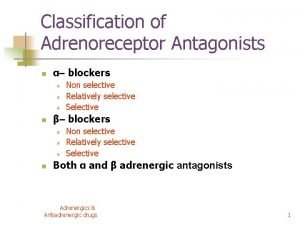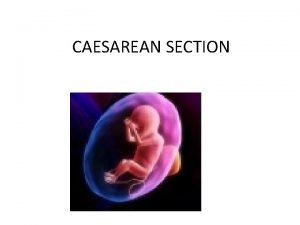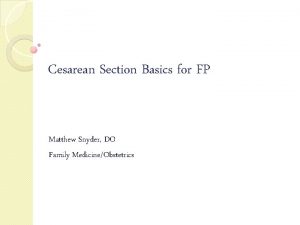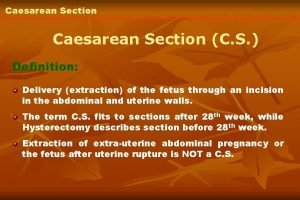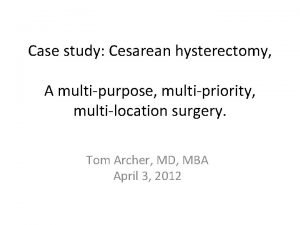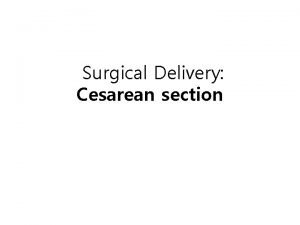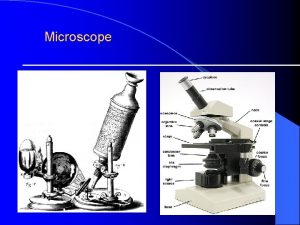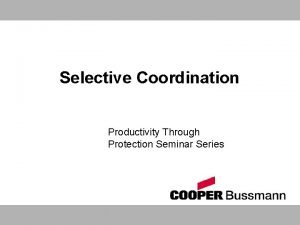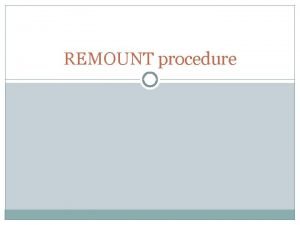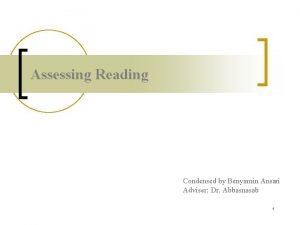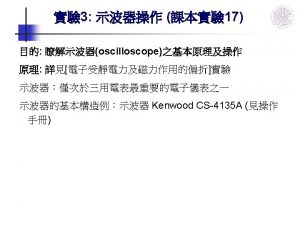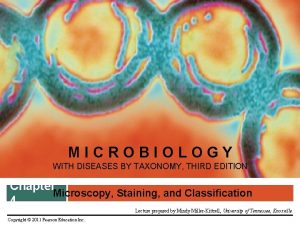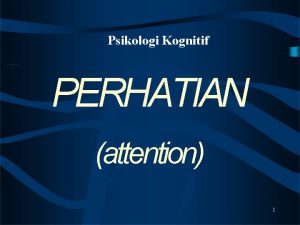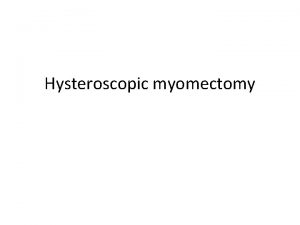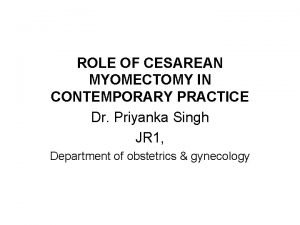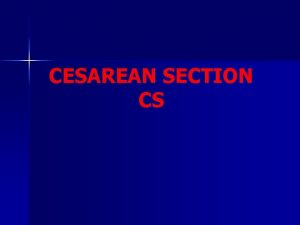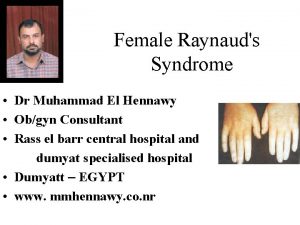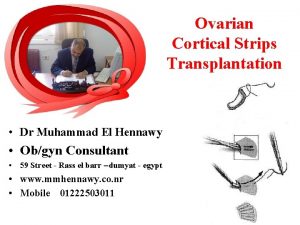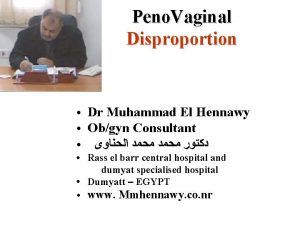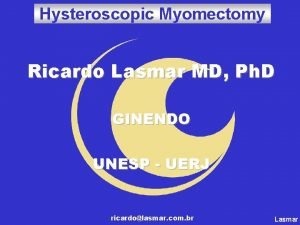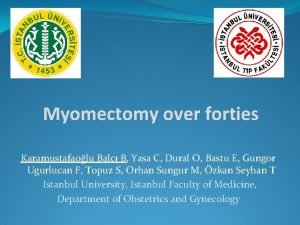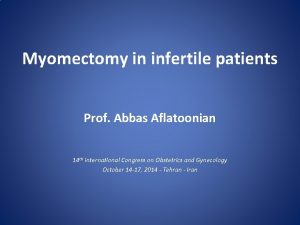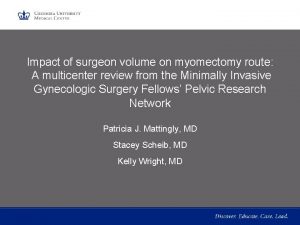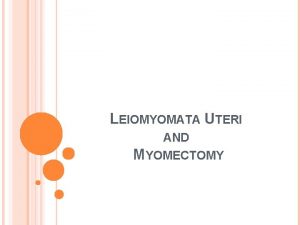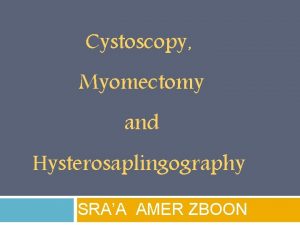Selective Cesarean Myomectomy Dr Muhammad M El Hennawy






























- Slides: 30

Selective Cesarean Myomectomy • Dr Muhammad M El Hennawy • Ob/gyn Consultant • 59 Street - Rass el barr –dumyat - egypt • www. mmhennawy. co. nr

Uterine leiomyomata = benign smooth muscle tumors of the uterus • Described based on location in the uterus: – Intramural: develop from within uterine wall, do not distort uterine cavity, <50% protruding into serosal surface – Submucosal: develop from myometrial cells just below endometrium, often protrude into and distort uterine cavity – Subserosal: originate from serosal surface of uterus, >50% protrudes out of serosal surface – Cervical: located in the cervix, rather than uterine corpus

PREVALENCE • The prevalence of uterine fibroids in pregnancy varies between 1. 6 and 10. 7 percent depending upon the trimester of assessment and the size threshold

Uterine myomas are observed in pregnancy more frequently now than in the past Because many women are delaying child bearing till their late thirties, which is the time for greatest risk of myoma growth. Also the use of ultrasonography has improved the diagnostic capability of detecting small myomas and has increased our knowledge of myomas in pregnancy.

CHANGE IN SIZE DURING PREGNANCY • The growth of fibroids during pregnancy using ultrasonography have refuted the commonly held belief that fibroids increase in size throughout gestation • Indeed, the majority of uterine fibroids (49 to 60 percent) have negligible (defined as <10 percent) change in volume across gestation, • while 22 to 32 percent increase in growth, and • 8 to 27 percent decrease in size • In those fibroids that do increase in size, most of the growth occurs in the first trimester, with little if any further increase in size during the second and third trimesters • Larger fibroids (>5 cm in diameter) are more likely to grow, whereas smaller fibroids are more likely to remain stable in size • The mean increase in fibroid volume during pregnancy is 12 percent, and very few fibroids increase by more than 25 percent

Time Of Diagnosis • = Simultaneous surgical removal of a previously diagnosed myoma during cesarean section • = Simultaneous surgical removal of a accidentally diagnosed myoma during cesarean section -Unavoidable caesarean myomectomy with a huge uterine fibroid located in the lower segment - Avoidable caesarean myomectomy

Indications For Myomectomy At Cesarean Section ( 7 Opinions ) • • 1 -Leave it 2 -Leave it with UAL 3 - Remove pedunculated fibroids only 4 - Remove pedunculated , anterior subserous or lower uterine segment fibroids • 5 - Remove all anterior uterine fibroids • 6 - Remove all fibroids • 7 - Selective removal of fibroids

Leave It • Caesarean myomectomy was practically absent from the obstetric literature until the last decade. • Myomectomy during cesarean section is strongly discouraged in all the leading textbooks despite the lack of any direct evidence supporting the approach • This was due to the high risk of haemorrhage associated with this procedure and difficulty in securing hemostasis and the need for blood transfusion or hysterectomy and increased post operative morbidity • Leaving them is not entirely without complications

leave It With UAL • Uterine artery ligation appears to be a promising method for treating pregnant women with uterine leiomyomas, who are undergoing cesarean section, • Because it is able to reduce postpartum blood loss and minimize the necessity of future surgery. • Fertility is apparently not compromised by this treatment, which offers obstetricians with another choice between observation and myomectomy for pregnant women with leiomyomas who are undergoing cesarean section

Remove Pedunculated Fibroids Only • Some authors are of the opinion that small pedunculated uterine fibroids should be routinely removed • Suturing and excision of the pedicle may be done easily

Remove Pedunculated , Anterior Subserous OR Lower Uterine Segment Fibroids Caesarean myomectomy when done is usually for pedunculated fibroids, anterior subserous fibroids and most especially fibroids in the lower uterine segment; Myomectomy in both instances allowed delivery of the fetus through the lower segment, making vaginal delivery in subsequent pregnancies possible.

Remove All Anterior Uterine Fibroids • Some authors are of the opinion that all anterior uterine fibroids should be routinely removed

Removal Of All Fibroids • Some authors are of the opinion that all uterine fibroids should be routinely removed • As they believe myomectomy during caesarean delivery does not increase the risk of hemorrhage, post operative fever or prolong hospital stay

Selective Removal Of Fibroids Myomectomy during caesarean delivery can be safely effective procedure in safe hands. The main principles of myomectomy during pregnancy are; 1. It should be done by an experience person. 2. It should be done in in a well equipped tertiary institution 3. With the advent of better anesthesia and availability of blood 4. It should be done with full consent of the patient. 5. It should be done in selected patients according to site and size of myoma 6. It should be done with techniques that decrease blood loss( UAL , UAE , High Oxytocin ) 7 - It is however important that baby must be delivered prior to attempting myomectomy Selection of patients for caesarean myomectomy reduces blood loss, anaemia and other complications.

How ? • After completion of the CS, • An interlocked suture was temporarily placed on the uterine incision without closing it. This allowed working from within or from the outer part of the uterus without having any significant bleeding from the incision. • Myomectomy was performed using sharp dissection. • Oxytocin drip was given during and after the enucleating the fibroid. .

• Enucleation of the fibroid is technically easier in the gravid uterus owing to the greater ‘looseness’ of the capsule • Retraction of the uterine muscle enhanced by syntocinon will help arrest haemorrhage • Also a uterus in the immediate postpartum phase is better adapted physiologically to control hemorrhage than in any other stage in a women’s life

• A three-layer closure of the incision is advocated in view of a larger surface area for closure. • After the first continuous locking suture to obliterate the endometrial surface, • A number of interrupted sutures were employed in both cases to obliterate the dead space. • The surface stitch was carried out continuously with an atraumatic needle

To Minimizing Blood loss • • Tourniquet UAL Electrocautery High dose Oxytocin

Tourniquet • It decreases intra-operative blood loss in cesarean myomectomy cases, • But Tourniquet method is not effective in the post-operative period since the tourniquet is taken out at the end of the operation.

Bilateral Ascending Uterine Artery Ligation • It decreases intra-operative blood loss in cesarean myomectomy cases, • And continues in decreasing blood loss in the postoperative period owing to its permanence quality.

Electrocautery • Avoid the extensive use of electrocautery with unipolar electrocoagulation • Because it is associated with an increased risk of uterine dehiscence and rupture in next pregnancy

High dose Oxytocin • A high dose oxytocin infusion to contract the uterus • Start infusion at rate of 20 m. U/min achieved (maximum rate ) • Intra-operatively after delivery of the baby and post-operatively continued for 12 -24 hours thereafter

Time Of Removal Of Fibroids -Myomectomy was done after delivering the baby. This was followed by suturing with adequate hemostasis -Large myoma situated over lower segment needing myomectomy before and for delivery of the fetus during LSCS

• Sufficient grouped and matched blood must be made available • With prophylactic broad spectrum antibiotics to combat infection and • Analgesics were given in the postoperative period

The Recurrence Of Uterine Fibroids After a myomectomy is not an uncommon finding. With the growing evidence in support of the safety of myomectomy at caesarean section, more cases are being reported. Although there is no documented recurrence rate of uterine fibroids after myomectomy at caesarean section, It is likely to be higher than after myomectomy in the nonpregnant state. .

Future Of Fertility • The future fertility and or subsequent pregnancy outcome was unaffected by caesarean myomectomy (Evidence level III)

Studies Several authors have published their results on myomectomy during the course of pregnancy when conservative treatment fails to relieve the woman of her symptoms. Michalas et al reported 18 cases of myomectomy during pregnancy 16 of whom delivered uneventfully at term. Burton et al and Exacoustos and Rosati have reported similar results with a good perinatal outcome but an increased preterm delivery rate. As far as myomectomy at the time of cesarean is concerned, some authors have cautioned against elective myomectomy at that time, because of reported high morbidity especially hemorrhage. Burton et al have reported that myomectomy at cesarean section may be safe in carefully selected patients. In 13 cesarean myomectomies reported by them only one was complicated by intraoperative hemorrhage. On the other hand Exacoustos and Rosati reported nine similar cases of whom three had severe hemorrhage needing hysterectomy. obstructing the lower part of the uterus were removed during cesarean section without any complication

. Ehigieba et al reported 25 cases of cesarean myomectomy in 12 women without any complications. They reported that anemia was the most common form of morbidity. Kwawukume reported cesarean myomectomy in 12 women, without any complications. Their mean operative time was 62. 08 minutes, which is similar to that found in our study. Roman and Tabsh in a retrospective study involving 111 women with myomectomy at cesarean section and 257 women undergoing cesarean section alone noted no significant difference in incidence of intraoperative hemorrhage, post partum fever, operative time, and length of hospital stay Omar et al report two cases wherein myomectomy had to be done to facilitate the delivery of the baby during cesarean section with uneventful intraoperative and postoperative period. Bmrton et al also shows that cesarean myomectomy is not as dangerous as generations of obstetricians have been trained to believe. Enucleation of the fibroid is technically easier in gravid uterus owing to greater looseness of the capsule Retraction of uterine muscles is enhanced by oxytocic agents to help arrest the hemorrhage.

These studies indicate that in selected patients and in experienced hands myomectomy during caesarean delivery can be safe procedure. But in which patients? Clearly large fundal fibroids intuitively should be avoided. Although no statistically significant difference was found between the patients who under went intramural myomectomy or myomectomy of fibroid >. 6 cm in size and the control group, this lack of difference may be attributed to a small sample size and therefore insufficient power to detect such a difference. Thus intramural myomectomy should be performed with caution. But in setting of symptomatic patient with an accessible subserosal fibroid and pedunculated fibroid or the patients with fibroid obstructing lower uterine segment the study carried out in USA indicated that this procedure can be safely carried out, several recent studies have described techniques which minimize blood loss at caesarean myomectomy, including uterine toniquet, bilateral uterine artery ligation, and electrocautery. There was also no increase in incidence of post operative fever, duration of hospital stay. No patient required hysterectomy.

My Opinion • The old dictum discouraging cesarean myomectomy should be reassessed. • Selective cesarean myomectomy can be a safe, effective procedure = in experienced hands = in a well equipped tertiary institution =With the advent of better anesthesia = with availability of blood = in selected patients according to site and size of myoma = with techniques that decrease blood loss( UAL , UAE , High Oxytocin ) = Meticulous attention to hemostasis (enucleation using sharp dissection with scissors and adequate approximation of the myometrium and all dead spaces to prevent hematoma formation ) • To eliminated the need for repeat laparotomy and its risk • To allow normal vaginal delivery • Myomectomy during CS can be performed in selected cases, but non selected patients had significant complications like postoperative ileus and postoperative atonic bleeding as blood transfusion greater than three packed red blood cells and two days longer than average hospitalization
 Non selective alpha blockers
Non selective alpha blockers Dua e sabah
Dua e sabah Atahiyatu
Atahiyatu Cesarean julius caesar
Cesarean julius caesar Cesarean instruments list with pictures
Cesarean instruments list with pictures C section complications
C section complications Cesarean hysterectomy steps
Cesarean hysterectomy steps Types of lscs
Types of lscs Nursing management of ophthalmia neonatorum
Nursing management of ophthalmia neonatorum Lower segment caesarean section ppt
Lower segment caesarean section ppt Icd 10 fraktur clavicula
Icd 10 fraktur clavicula Baseball stitch classical cesarean
Baseball stitch classical cesarean Selective vulnerability
Selective vulnerability Selective set operation
Selective set operation Area selective deposition
Area selective deposition Selective incorporation definition
Selective incorporation definition Full market coverage segmentation
Full market coverage segmentation Selective compliance assembly robot arm
Selective compliance assembly robot arm Emb agar gram positive bacteria
Emb agar gram positive bacteria Selective coordination
Selective coordination Stabilizing selection
Stabilizing selection Clinical remount
Clinical remount Contoh open coding axial coding selective coding
Contoh open coding axial coding selective coding Beben benyamin
Beben benyamin Selective disclosure
Selective disclosure Selective distribution
Selective distribution Selective distribution
Selective distribution Immunofluorescence
Immunofluorescence Selective demand stimulation example
Selective demand stimulation example Selective mutism university
Selective mutism university Divided attention definition
Divided attention definition
